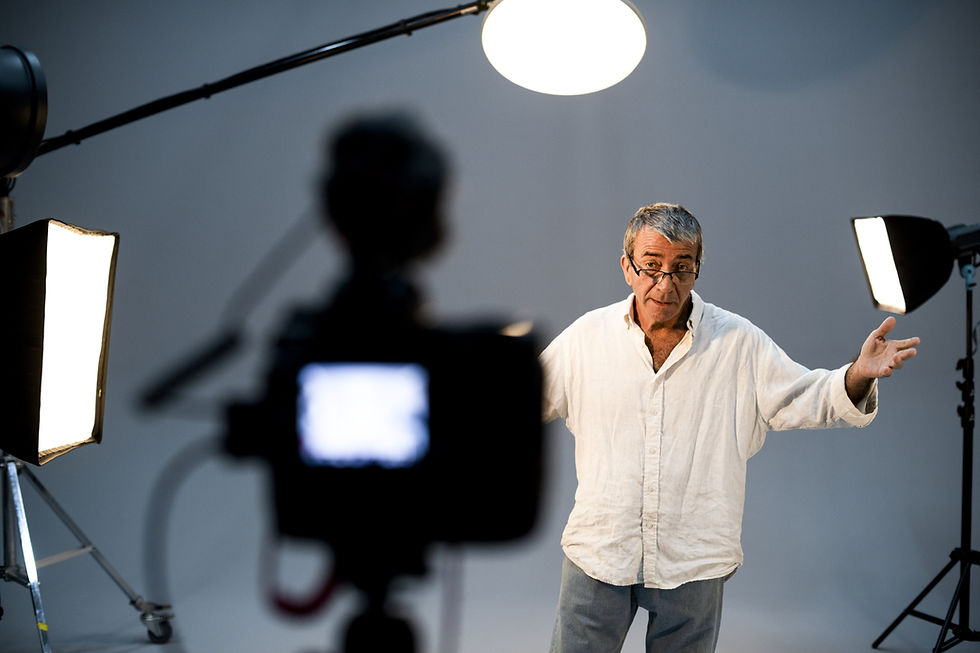Mastering Your Audition Environment with the Audition Clock
- Faith Hibbs-Clark

- Jan 10
- 3 min read
-- By Faith Hibbs-Clark

Why Build an Audition Environment?
Creating a believable audition environment is one of the most powerful tools an actor can use to stand out in an audition - and it's more than just reciting lines. It's about transforming a scene into a compelling story that captures the decision-maker's attention. Using the CMFA Acting Science Method™ Audition Clock, actors can map out their audition space with precision and elevate their performance. Here is how to make it work for you.

A well-crafted audition environment isn’t just a nice touch—it’s essential. Here are five key reasons why it matters:
1️⃣ It Enhances Believability: By creating a rich, immersive story, you pull the viewer into the scene with you. This connection makes your audition unforgettable.
2️⃣ Boosts Neural coupling: Neural coupling aligns your brain’s emotions with that of the “receiver” (casting directors, directors, etc.). This synchrony helps them feel what you’re feeling, strengthening the emotional impact of your performance.
3️⃣ It Anchors You to the Scene: Avoid looking like an actor performing on a blank canvas. A mapped-out environment grounds you, making your performance feel rooted in a real story.
4️⃣ Reduces Distracting Darting Eyes: Actors often lose focus, and darting eyes can break the connection with the viewer. Defining your space creates intentionality, keeping your gaze steady and meaningful.
5️⃣ It Sets You Apart: Details make all the difference. Bringing your A-game to build a thoughtful, dynamic environment shows professionalism and makes you memorable to decision-makers.
The Power of the Audition Clock
My Audition Clock is a simple yet game-changing visual tool for establishing your scene. It uses the concept of a clock face to map out where people, key objects, and actions occur in your performance space.
Start at 12 o’clock by placing the camera directly in front of you.
Use conversational distance: Imagine your arm’s length as the range for natural interaction. Beyond this, adjust your gaze to reflect whether someone is closer (intimate distance) or farther away (social distance).
Position characters and objects carefully: For example, a key object should not be at eye-level as it risks being mistaken for another person. Instead, use intentional eye lines to clearly separate your focus points.

Key Skills to Master
Gaze Consistency: The “power of gaze” can make or break your audition. Your eye movement should communicate emotion, intention, and action while staying anchored to the mapped-out environment in the scene.
Detailing Your Space: Consider the environment. Are you inside or outside? Is it crowded? Where are the exits? Use these elements to infuse subtle but impactful realism into the scene.
Putting It into Practice
The Audition Clock lets actors rehearse and visualize precisely where characters, key objects, and actions should align in their scene. Whether it’s marking key focal points on paper or using a tablet to create a virtual map, this resource helps you stay consistent and polished. It’s this level of detail that sets professional actors apart.
By combining these techniques with tools like the Audition Clock, you can master the art of creating an audition environment. The result? A performance that doesn’t just meet expectations but leaves a lasting impression.
Final Thoughts
Success in auditions boils down to the details, and mastering your environment with the Audition Clock is one of many ways I teach you to elevate your auditions from competent to compelling.
By focusing on believability, neural coupling, and precision, you’ll not only capture the eyes of the decision-makers—you’ll stick in their minds.
Want to learn more about The Acting Science Method™? Sign up for my next Film Auditioning Weekend Intensive Workshop. If you are already trained in this method, you can take the Gaze for Actors 4-week workshop. Let the power of science, transform your art!
ABOUT THE AUTHOR:

Faith is a body language expert who specialized in deception detection before becoming a casting director and working in the film industry for over 25 years. She is the founder of the Communication Method for Actors, LLC & the creator of the Acting Science Method ™. www.cmfatraining.com
What are the actors saying?
What is casting saying?
-modified%20(1).png)



Comments